
Romanesque architecture is an architectural style of medieval Europe characterized by semi-circular arches. There is no consensus for the beginning date of the Romanesque style, with proposals ranging from the 6th to the 11th century, this later date being the most commonly held. In the 12th century it developed into the Gothic style, marked by pointed arches. Examples of Romanesque architecture can be found across the continent, making it the first pan-European architectural style since Imperial Roman architecture. The Romanesque style in England is traditionally referred to as Norman architecture.

Glendalough is a glacial valley in County Wicklow, Ireland, renowned for an Early Medieval monastic settlement founded in the 6th century by St Kevin. From 1825 to 1957, the head of the Glendalough Valley was the site of a galena lead mine. Glendalough is also a recreational area for picnics, for walking along networks of maintained trails of varying difficulty, and also for rock-climbing.

Hylton Castle is a stone castle in the North Hylton area of Sunderland, Tyne and Wear, England. Originally built from wood by the Hilton family shortly after the Norman Conquest in 1066, it was later rebuilt in stone in the late 14th to early 15th century. The castle underwent major changes to its interior and exterior in the 18th century and it remained the principal seat of the Hylton family until the death of the last Baron in 1746. It was then Gothicised but neglected until 1812, when it was revitalised by a new owner. Standing empty again until the 1840s, it was briefly used as a school until it was purchased again in 1862. The site passed to a local coal company in the early 20th century and was taken over by the state in 1950.

Burgh by Sands ( "Brough") is a village and civil parish in the City of Carlisle district of Cumbria, England, situated near the Solway Firth. The parish includes the village of Burgh by Sands along with Longburgh, Dykesfield, Boustead Hill, Moorhouse and Thurstonfield.It is notable as the site of the first recorded North African (Moorish) military unit in Roman Britain, garrisoning the frontier fort of Aballava on Hadrian's Wall in the 3rd century CE. It is also where Edward I of England died in 1307.

Gallarus Castle is a four-storey rectangular tower house in Baile na nGall, County Kerry, Ireland and is notable as one of the few fortified structures preserved on the Dingle Peninsula.

The Hospital of St Cross and Almshouse of Noble Poverty is a medieval almshouse in Winchester, Hampshire, England. It has been described as "England's oldest and most perfect almshouse". Most of the buildings and grounds are open to the public at certain times. It is a Grade I listed building.
A fortified church is a church that is built to serve a defensive role in times of war. Such churches were specially designed to incorporate military features, such as thick walls, battlements, and embrasures. Others, such as the Ávila Cathedral were incorporated into the town wall. Monastic communities, such as Lérins Abbey, are often surrounded by a wall, and some churches, such as St. Arbogast in Muttenz, Switzerland, have an outer wall as well. Churches with additional external defences such as curtain walls and wall towers are often referred to more specifically as fortress churches or Kirchenburgen.

St John the Evangelist's Church is in the village of Newton Arlosh, Cumbria, England. It is an active Anglican parish church in the deanery of Carlisle, the archdeaconry of Carlisle, and the diocese of Carlisle. It was built as a fortified church, one of a number of such buildings near the Scottish border. It was restored and extended in the 19th century. The church is recorded in the National Heritage List for England as a designated Grade I listed building.

Romanesque architecture is an architectural style of medieval Europe characterised by semi-circular arches. The term "Romanesque" is usually used for the period from the 10th to the 12th century with "Pre-Romanesque" and "First Romanesque" being applied to earlier buildings with Romanesque characteristics. Romanesque architecture can be found across the continent, diversified by regional materials and characteristics, but with an overall consistency that makes it the first pan-European architectural style since Imperial Roman Architecture. The Romanesque style in England is traditionally referred to as Norman architecture.

St Michael's Church is in the village of Burgh by Sands, Cumbria, England. It is an active Anglican parish church in the deanery of Carlisle, the archdeaconry of Carlisle, and the diocese of Carlisle. Its benefice is united with those of St Andrew, Aikton, St Mary, Kirkandrews-on-Eden with Beaumont, and St Peter, Kirkbampton. The church is recorded in the National Heritage List for England as a designated Grade I listed building. It is a fortified church standing on the line of Hadrian's Wall, and is unique in having had two fortified towers.
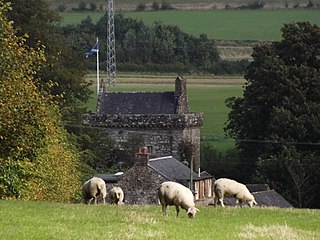
Bonshaw Tower is an oblong tower house, probably dating from the mid-16th century, one mile south of Kirtlebridge, Dumfries and Galloway, Scotland, above the Kirtle Water. It is adjacent to a 19th-century mansion. The tower was one of a number of structures built along the Scottish border in the 1500s as protection against incursions by the English.
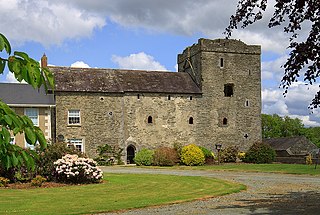
Athclare Castle is a Tudor tower house in the Dunleer area of County Louth in Ireland. Built in the 1550s, Athclare was built for the Barnewell family, and is typical of defensive architectural structures built in the Pale during the Tudor period in Ireland. Athclare has been extended and adapted in the centuries since its construction and is classified as a site of National social historical importance by the Irish National Inventory of Architectural Heritage.
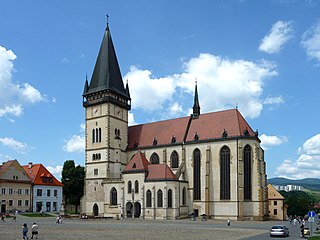
Basilica of St Giles in Bardejov, Slovakia, is a Gothic sacral building, which is situated in the northern part of the Town-Hall square. Bardejov is located in the larger area of town Prešov in the region called Šariš.

Athlumney Castle is a tower house and fortified house and a National Monument in Navan, Ireland.
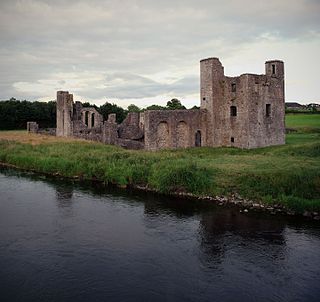
St. John's Priory is a medieval priory and hospital and National Monument located near Trim, County Meath, Ireland.

Shanmuckinish Castle is a ruined tower house located in Drumcreehy civil parish of County Clare, Ireland.
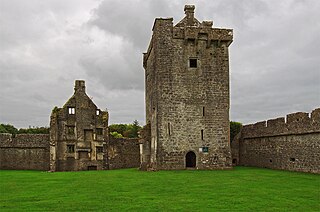
Pallas Castle is a tower house and National Monument located in County Galway, Ireland.
The Tower of Apollonia or Tower of Eleftheres stands on the coastal hill 27 kilometres (17 mi) east of the Strymon River estuary in the Thracian Sea. The small settlement of Pyrgos, some 700 m northeast of the tower, is named after it.
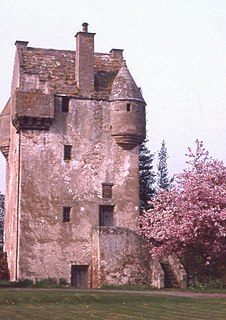
Coxton Tower is a late sixteenth-century tower house in Moray, Scotland. Heavily fortified, it was built around 1590, with substantive repairs in 1635 and 1645, but its design is reminiscent of much older buildings. It has not been occupied since around 1867 except to house Canadian soldiers during the Second World War, but was renovated in 2001 to help protect the fabric of the structure, which is designated a Category A listed building.

The Zemo Nikozi church of the Deity, also known as Ghvtaeba (ღვთაება), is a medieval Georgian Orthodox cathedral in the Gori Municipality, in Georgia's east-central region of Shida Kartli. It is part of the complex which also includes a bell-tower, an episcopal palace, and a circuit wall. The complex is inscribed on the list of Georgia's Immovable Cultural Monuments of National Significance.



















